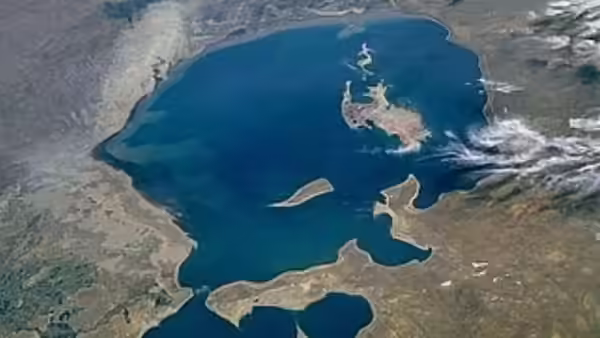Shrinking Lakes Across the World Due to Environmental Threats

IN NEWS — Shrinking Lakes Across the World Due to Environmental Threats
Analysis
- Global Concern: Several major lakes around the world are drying up rapidly due to climate change, water diversion, pollution, and unsustainable agricultural practices.
- Ecological Impact: The decline in lake water levels is shrinking wildlife habitats, threatening biodiversity, and altering regional microclimates.
- Socio-economic Impact: Local livelihoods dependent on fisheries, agriculture, and tourism are under stress, leading to water insecurity and migration pressures in affected regions.
- Human Activity: Excessive irrigation withdrawals, river diversions, and mining are aggravating the depletion of these crucial freshwater sources.
- Climate Linkage: Prolonged droughts and rising global temperatures have accelerated evaporation rates and reduced replenishment.
Major Lakes Facing Rapid Shrinkage
1. Lake Poopó (Bolivia)
- Once the second-largest lake in Bolivia, located in the Altiplano region.
- Suffered extensive water loss due to climate change, mining, and agricultural diversion.
- Impact: Loss of local fisheries, displacement of indigenous communities, and severe damage to the regional ecosystem.
2. Aral Sea (Central Asia)
- Located between Kazakhstan and Uzbekistan.
- Lost over 90% of its volume mainly due to diversion of the Amu Darya and Syr Darya rivers for irrigation.
- Impact: Creation of toxic dust storms, increased desertification, and collapse of local fisheries.
3. Lake Mead (United States)
- The largest reservoir in the U.S., situated on the Colorado River.
- Faces historic water level decline due to prolonged drought, below-average rainfall, and rising demand.
- Impact: Threatens water security for millions and affects hydropower generation and ecosystem health.
4. Lake Chad (Africa)
- Shared by Chad, Niger, Nigeria, and Cameroon.
- Once one of Africa’s largest freshwater lakes, now reduced to a fraction of its size.
- Causes: Climate change, droughts, and excessive irrigation use.
- Impact: Food and water insecurity, decline in pastoral livelihoods, and loss of biodiversity.
5. Lake Urmia (Iran)
- One of the largest saltwater lakes globally, located in northwestern Iran.
- Has lost more than 80% of its water volume due to agricultural water extraction and climate-linked droughts.
- Impact: Salt storms, collapse of aquatic ecosystems, and socio-economic displacement.
6. Dead Sea (Middle East)
- Located between Jordan, Israel, and Palestine.
- Water levels declining due to diversion of the Jordan River and industrial mineral extraction.
- Impact: Sinkholes, loss of tourism sites, and ecological degradation.
Static Information
| Lake | Location | Type | Primary Cause of Drying |
|---|---|---|---|
| Lake Poopó | Bolivia | Freshwater | Climate change, mining |
| Aral Sea | Central Asia | Inland saline sea | Irrigation diversion |
| Lake Mead | USA | Reservoir | Drought, overuse |
| Lake Chad | Africa | Freshwater | Climate change, water diversion |
| Lake Urmia | Iran | Saltwater | Agriculture, drought |
| Dead Sea | Jordan–Israel–Palestine | Salt lake | River diversion |
UPSC Relevance
- GS Paper 1: Physical Geography – Lakes, Climate Change Impacts.
- GS Paper 3: Environment, Disaster Management, Sustainable Resource Use.
- Essay / GS Paper 3 Linkage: “Depleting Freshwater Resources – A Global Environmental Crisis.”